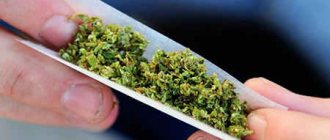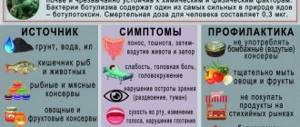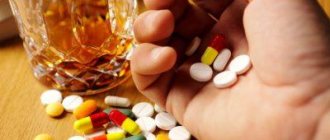Development mechanism
Intoxication that develops during oncology occurs in almost every patient.
This is due to the fact that during malignant neoplasms, normal metabolic processes are disrupted, and toxic endogenous elements accumulate in the tissues and biological fluids of the body. Cancer intoxication in ICD-10 does not have its own code and is coded according to the initial diagnosis. The ICD code is important for determining the diagnosis using a sick leave certificate.
Endogenous poisoning in oncology is caused by the simultaneous influence of several provoking factors on the body:
- Violation of metabolic processes.
- Disintegration of a malignant tumor.
- Accumulation of medications used during treatment.
A certain role in the development of endogenous intoxication in cancer is played by surgery, inflammatory reactions, and the location of the tumor, which helps a non-attending physician determine the ICD code of the disease.
Is it possible to be poisoned by Naphthyzin?
Considering the vasoconstrictor effect of the drug and its ability to cause addiction in patients, the question arises whether it is possible to be poisoned by Naphthyzin, and how harmful the drops are when treating rhinitis in a child.
Consequences of improper treatment
Strictly speaking, Naphthyzin is not a cure for the common cold as such. These drops serve as an aid to facilitate breathing in various respiratory diseases. Therefore, you cannot count on a therapeutic effect for a runny nose when using only this medicine. Moreover, you cannot independently increase the recommended doses and frequency of use of Naphthyzin, because Is it dangerous.
An uncontrolled increase in doses can lead to dependence on the action of the drug, which will force you to increase its amount even more. And this will already lead to an overdose and poisoning with Naphthyzin.
Consequences of use in children
Sometimes small children are brought to the intensive care unit whose parents have ignored the warnings in the instructions regarding the age restrictions for the use of Naphthyzin. The mucous membranes of a small child are much more delicate and sensitive than those of an adult. Therefore, even small doses, according to parents, can cause the child to develop adverse reactions with quite serious consequences. Under no circumstances should you use Naphthyzin, the concentration of which does not correspond to the age of the child or in children under 1 year of age!
What happens if you take medicine
The worst-case scenario can await a baby who drank the contents of a bottle of Naphthyzin due to the carelessness of his parents. This happens most often in families with small children, where the mother or other adults are drug dependent on Naphthyzin. Drops that are used several times a day may end up on the sofa, under the pillow, on the windowsill, that is, where the baby can easily get them and drink.
You can be poisoned by a low-quality, expired drug, even if you follow all other rules of use.
Cancer intoxication ICD 10 - symptoms, causes and treatment
Almost all systems and organs in the human body are exposed to infectious toxic damage, but the central nervous system is most affected. It is even more difficult for children, especially young ones, to endure intoxication of the body.
They have not yet fully developed mechanisms to resist the disease. Intoxication can be caused directly by viral particles, decay products of disease-infected cells of the human body and macrophages - immune defense cells.
Cancer intoxication develops in humans at severe stages of cancer.
Unfortunately, more and more people around the world are suffering from this terrible disease.
The person’s condition during this period is very difficult.
What is it, and how to alleviate the patient’s condition at such a time?
MEDICAL CERTIFICATE OF DEATH.
When drawing up a conclusion on the cause of death (completing the pathological diagnosis and clinical-anatomical epicrisis) and filling out the form of a medical (medical) death certificate, the concepts “initial cause of death” and “immediate cause of death” are used.
The underlying cause of death is, in accordance with ICD-10, as stated above, a) an illness or injury that caused a successive series of disease processes that directly led to death, b) the circumstances of the accident or act of violence that caused the fatal injury.
In a pathoanatomical diagnosis, the initial cause of death is the main disease in a monocausal diagnosis structure or the nosological unit ranked first in a combined main disease.
It is the initial cause of death that is indicated and encrypted (coded) according to ICD-10 in the medical death certificate, and is indicated first in the conclusion about the cause of death.
In the conclusion about the cause of death, all nosological units included in the structure of the combined underlying disease should also be listed.
The immediate cause of death is a fatal complication (but not an element of the mechanism of death), which is also indicated in the relevant paragraphs of the report on the cause of death and the medical certificate of death.
It is well known that fatal outcomes can occur in which the underlying disease (the original cause of death) is also the immediate cause of death, without fatal complications.
In some cases, if justified, it is possible to supplement the conclusion on the cause of death after stating the immediate cause of death (fatal complication) - “in case of events - the mechanism of death”, as well as indicate the most important concomitant diseases that required therapeutic and diagnostic measures (in the last episode of the patient’s treatment for medical care), which is due to economic considerations.
In addition, if a patient dies after a surgical intervention that is important for thanatogenesis, a diagnostic or other medical intervention, it is necessary to indicate it and how many days (hours) after it the death followed.
Thus, in the conclusion about the cause of death, indicate that “The death of the patient (full name, age) occurred (followed) from - ... (the original cause of death), in combination, or in the presence, or against the background of - ... (with a combined underlying disease) , complicated - ... (immediate cause of death - fatal complication)."
Less commonly used is another version of the formulation of the conclusion about the cause of death: “The main disease (initial cause of death) of the deceased, full name, age - ..., fatal complication (immediate cause of death) - ....”
Different and unsuccessful reporting of the cause of death is widespread. In particular, it is indicated: “The death of the patient - full name, age, sufferer - underlying disease (if necessary - in combination with ...) - occurred from - fatal complication (immediate cause of death).”
However, despite the apparent simplicity of this formulation, due to the legal problems that arise in this case (the words “occurred from” are often interpreted as an indication of the original cause of death) and in connection with the requirements of ICD-10, it should be abandoned.
In the conclusion about the cause of death, one should not indicate the presence of a coincidence or discrepancy in diagnoses, opinions on the course of the treatment process - all this is deciphered only in the clinical-anatomical epicrisis, which is not given to relatives at their request.
A medical (medical) death certificate is filled out by a doctor according to international rules, in accordance with the requirements of ICD-10, regulatory documents of the Ministry of Health of the Russian Federation and the Moscow Department of Health, based on the design of the pathological diagnosis (or the final clinical diagnosis, if an autopsy was not performed), in the same terminology.
A medical death certificate is at the same time a medical, statistical and legal document; death certificate forms are special reporting documents, therefore strict adherence to the rules for their storage, completion and recording set out in the relevant orders is required.
By order of the Ministry of Health of the Russian Federation dated 08/07/98 No. 241 “On the improvement of medical documentation certifying cases of birth and death in connection with the transition to ICD-10” - from 01/01/99 new forms must be filled out: No. 106/u- 98 or, for perinatal death - No. 106-2/u-98).
A medical death certificate must be issued to the relatives of the deceased or persons authorized by them no later than 24 hours after the pathoanatomical autopsy (or after the cause of death has been established - the final clinical diagnosis has been completed, if an autopsy has not been performed) in accordance with the requirements of the Law of the Russian Federation of 1995 “On burial and funeral affairs” "
It is strictly prohibited to release a corpse from the pathological department (with the exception of transferring the corpse for a forensic medical examination or to specialized infectious diseases dissections for a pathological autopsy) without a medical death certificate.
A medical death certificate may be issued with the designation “final”, “provisional”, “final instead of preliminary or final”. This procedure was adopted in order not to delay the registration of death in the registry office.
However, you should remember the need to submit the final certificate to the statistical authorities within 7 days (in the presence of an infectious disease) or one month (in the case of other diseases), if a preliminary certificate was issued or the final one was changed.
In some cases, at the written request of the relatives of the deceased or their authorized persons, it is allowed to re-issue a medical death certificate to replace the one lost by relatives. A certificate with a new number is issued, just as in cases where it was issued instead of a preliminary one;
a corresponding entry is made in the journal of registration and issuance of medical death certificates and the territorial internal affairs bodies are informed by telephone message. The same should be done if relatives refuse to bury the deceased (unclaimed corpses) and they lose the already issued death certificate (or if it is impossible to find in such cases the relatives of the deceased to whom the certificate was previously issued).
In pathology departments, it is allowed for a medical pathologist to fill out items on a medical death certificate - full name, age of the deceased, date of death, causes of death and their codes, and items relating to the deceased's passport data - by a nurse or other department employee responsible for issuing medical death certificates to relatives the deceased or their authorized persons.
A medical death certificate is issued from the pathology department by a specially authorized employee (doctor, orderly, medical registrar, etc.) to the relatives of the deceased or their authorized persons only upon presentation of the passport of the deceased and the passport of the person receiving the certificate and strictly against the signature of the recipient on the spine of the certificate.
The recipient's passport data must also be entered on the counterfoil of the death certificate, which remains in the department, and in the appropriate journal. If you do not have a passport, documents that legally replace a passport must be presented.
Entries in medical death certificates must completely coincide with the corresponding entries in medical documentation (pathoanatomical diagnosis, conclusion on the cause of death, etc.). In some cases, inconsistencies in these documents can have negative legal consequences.
Each medical and preventive institution that has a pathology department must issue internal orders regulating the rules for working with medical death certificates in accordance with the orders of the Ministry of Health of the Russian Federation and the Moscow Department of Health.
The medical death certificate form is international. The new certificate form in the Russian Federation, model 1998, contains paragraph “d)”, and, like the earlier form, special empty cells opposite points “I, a), b), c), d)” and “II” , intended to record the code of the underlying cause of death according to ICD-10.
The condition recorded on the bottom completed line of part “I” in list “a, b, c” of the certificate is the underlying cause of death used for statistical developments. However, in some cases, especially when certificates are inaccurately completed, it is necessary to select another condition as the original cause of death.
The selection rules for statistical institutions are clearly regulated in ICD-10 (vol. 2). To indicate the circumstances of external influences (trauma, poisoning, etc.), use the line “d)” after documenting these circumstances.
Degrees of Naphthyzine poisoning
There are three degrees of Naphthyzin poisoning in children:
- I degree – mild. Blood pressure is within normal limits, drowsiness and a slight decrease in appetite are observed.
- II degree – moderate severity. Lack of appetite, apathy, pale skin, nausea, vomiting and irregular heart rhythm.
- III degree – severe. The patient falls into a coma, severe depression of the central nervous system is observed. High probability of death.
The first degree of poisoning is not dangerous. The drug must be discontinued. When diagnosing degrees II and III, the help of a doctor is required. In severe cases of intoxication, the patient is placed in intensive care.
Clinical picture
Cancerous, gradually developing intoxication has a very diverse clinical picture. Symptoms of internal poisoning of the body depend on:
- Stages of malignant neoplasm, which can be found out by looking at the ICD code.
- Places of localization of the neoplasm.
- The degree of dysfunction of the organ affected by the oncological process.
- Use of chemotherapy.
Symptoms of intoxication in malignant diseases are associated with a general decrease in the body's defenses and with immunodeficiency, which is manifested by frequent infectious diseases.
The reason for the deterioration in well-being is also related to the dysfunction of those organs where the development of cancer cells occurs. The addition of organ dysfunction in cancer is indicated by additional diagnoses, which also have their own ICD code.
Lack of treatment for endogenous poisoning of the body can become the main cause of death of the patient, since the affected organs can no longer cope with the load placed on them.
Symptoms of intoxication intensify during chemotherapy procedures, which is explained by the breakdown of cancer cells under the influence of therapy.
Prognosis for recovery
The most optimistic prognosis is when drinking ethyl alcohol. However, the outcome largely depends on the dose of alcohol and timely assistance provided. With regular alcohol consumption, liver destruction, gastrointestinal diseases, neurological and mental disorders are inevitable. The most severe consequences are poisoning with methyl alcohol or ethylene glycol. These are blindness, cirrhosis of the liver, gastritis, ulcers, kidney failure. Disability or even death of a person are common consequences of using a surrogate. In order not to endanger your life, you should drink only high-quality and licensed alcohol.
How does intoxication develop?
Intoxication by cancer cells occurs as a result of the progression and subsequent disintegration of a malignant tumor. In addition, anticancer therapy can also provoke its occurrence.
There is no ICD-10 code for cancer intoxication due to the fact that it is a combination of symptoms that occur with one type of tumor or another. Therefore, the ICD code is used only to make an accurate diagnosis.
What happens in the human body?
A cancerous tumor constantly grows, using fats, proteins and carbohydrates needed by the body. As a result, the body does not receive enough of these substances, which causes its gradual depletion.
All this leads to impaired blood circulation. A malignant tumor cannot form a normal circulatory system, which leads to the death of its cells, which are immediately spread by blood throughout the body, poisoning it.
Chemotherapy can also cause cancer intoxication. Treatment involves the use of various drugs that have a detrimental effect on tumor cells. They also die and spread throughout the body.
When the cells of a malignant tumor die, many human life processes are disrupted.
Processes:
- The amount of potassium in the blood increases, which leads to disruption of the cardiac system. Moreover, such failures can even cause death due to cancer intoxication.
- Increased levels of uric acid, which has a detrimental effect on the kidneys, leading to their failure.
- An increase in phosphate levels leads to a decrease in calcium levels. As a result, a person experiences disturbances in the functioning of the nervous system, and seizures may occur. In addition, calcium phosphate also has a negative effect on kidney health.
- Lactic acid accumulates in the body, which gradually causes dehydration.
As a result, a person begins to feel worse and worse, and intoxication with harmful substances develops.
According to ICD 10, the severity of cancer intoxication depends on several factors.
Factors:
- General state,
- How actively does tumor decay occur?
- The presence of surgical interventions,
- The presence of any specific features of the course of the disease,
- The presence of chronic diseases,
- Possible blood loss.
All these factors can have a certain impact on the disintegration of malignant formation and speed up the process.
Taking into account all the factors and symptoms, a specific ICD 10 code, characteristic of a certain type of cancer, is used to indicate the diagnosis on the sick leave.
Unfortunately, the prognosis in most cases is disappointing. Death from cancer intoxication occurs quite often due to the failure of some organs and systems due to poisoning.
Unfortunately, the prognosis in most cases is disappointing. Death from cancer intoxication occurs quite often due to the failure of some organs and systems due to poisoning.
Classification
Before moving on to the classification, it is worth understanding what is a surrogate for alcohol. This is a combination of ethanol with other types of alcohol, adding various harmful impurities. Such drinks are not intended for internal consumption and are highly toxic .
ICD 10 poisoning with alcohol substitutes does not contain. However, there is code T51 “Toxic effects of alcohol,” which includes subheadings about intoxication with ethanol, methanol and other types of alcohols. The entire surrogate can be divided into 2 groups: with ethyl alcohol (true) and without it (false). The first belongs to:
- butanol is a monohydric alcohol, 30 ml is a lethal dose;
- denatured alcohol - industrial alcohol that contains ethanol, methanol, kerosene, dye and other additives;
- colognes, lotions - based on ethanol and various aromatic substances;
- sulfite or hydrolysis alcohol are strong toxins;
- stains, polishes and others.
The second group includes drinks with methyl alcohol and ethylene glycol (brake fluid). Poisoning with them is extremely dangerous. Both substances are extremely toxic; without timely medical care, they lead to changes that are incompatible with life.
In order to provide a person with timely help, you need to know about the symptoms of intoxication.
Intoxication syndrome: signs and symptoms of intoxication
Cancer intoxication manifests itself differently in each person depending on their condition. However, there are symptoms that are common. With such intoxication, changes in appearance and disturbances in the functioning of the nervous system are noted.
Symptoms:
- Weakness, increased fatigue,
- Apathy, psychosis, depression, aggressiveness,
- Insomnia,
- The skin becomes pale, with a yellowish tint,
- Blueness may be present
- Mucous surfaces and skin become dry.
- The man is sweating a lot
- Lack of appetite, which leads to severe weight loss,
- Frequent nausea and vomiting
- Intestinal dysfunction
- Increased body temperature
- Painful sensations in the head, as well as in the locations of the cancerous tumor,
- Poor immunity, and therefore a strong susceptibility to various diseases,
- Pain in bones and muscle tissue,
- Heart dysfunction.
These are the main signs of how the decay of a tumor manifests itself in the body. Depending on the location of the cancer, other symptoms of intoxication may be present.
Everyone knows such an illness as a cold or ARVI - both children and adults. Runny nose and cough, chills, muscle aches, and fever. All these symptoms indicate the presence of an acute viral infection.
Viral diseases are dangerous not only because of complications of the upper respiratory tract that appear after an illness. During the height of the disease itself or after it, the body often cannot withstand the load.
Intoxication syndrome manifests itself differently in each person, but the passage of the viral infection significantly worsens. What are the symptoms of intoxication during ARVI in children and adults? How to detoxify the body and help it reduce the harmful effects of the disease?
Most often, infectious diseases are accompanied by symptoms of general intoxication. ARVI is no exception. Fever, constant headache, joint pain, body aches, vomiting and nausea are symptoms of toxic damage to the body that explain the person’s poor health.
Almost all common seasonal viruses cause such complaints, expressed to a certain degree. But the clear leader is the flu.
In addition to the above complaints, as a rule, there are:
- dizziness;
- general weakness;
- muscle pain;
- decreased taste and loss of appetite;
- decrease in blood pressure.
In 50% of cases with ARVI, these symptoms are ahead of the typical manifestations of a cold: sore throat, cough, runny nose. During severe illness, toxic shock may occur, which is accompanied by a sharp decrease in blood pressure.
Excluded:
- fever of unknown origin (during): childbirth (O75.2)
- newborn (P81.9)
Facial pain
Excluded:
- atypical pain in the face (G50.1)
- migraine and other headache syndromes (G43-G44)
- trigeminal neuralgia (G50.0)
Included: pain that cannot be attributed to any specific organ or part of the body
Excluded:
- chronic pain personality syndrome (F62.8)
- headache (R51)
- pain (in): stomach (R10.-)
- back (M54.9)
- mammary gland (N64.4)
- chest (R07.1-R07.4)
- ear (H92.0)
- pelvic area (H57.1)
- joint (M25.5)
- limbs (M79.6)
- lumbar region (M54.5)
- pelvic and perineal areas (R10.2)
- psychogenic (F45.4)
- shoulder (M25.5)
- spine (M54.-)
- throat (R07.0)
- language (K14.6)
- dental (K08.8)
General physical exhaustion
Excluded:
- weakness: congenital (P96.9)
- senile (R54)
- nervous demobilization (F43.0)
Senile age without mention of psychosis
Old age without mention of psychosis
Excludes: senile psychosis (F03)
Brief loss of consciousness and vision
Excluded:
- neurocirculatory asthenia (F45.3)
- orthostatic hypotension (I95.1)
- neurogenic (G23.8)
- shock: NOS (R57.9)
- cardiogenic (R57.0)
- complicating or accompanying: abortion, ectopic or molar pregnancy (O00-O07, O08.3)
- labor and delivery (O75.1)
- sinocarotid (G90.0)
Excluded: convulsions and paroxysmal attacks (with):
- dissociative (F44.5)
- epilepsy (G40-G41)
- newborn (P90)
Excluded:
- shock (caused by): anesthesia (T88.2)
- anaphylactic (due to): NOS (T78.2)
- adverse reaction to food (T78.0)
- whey (T80.5)
Included: swollen glands
Excluded: lymphadenitis:
- NOS (I88.9)
- spicy (L04.-)
- chronic (I88.1)
- mesenteric (acute) (chronic) (I88.0)
Excluded:
- ascites (R18)
- hydrops fetalis NOS (P83.2)
- hydrothorax (J94.8)
- edema: angioedema (T78.3)
- cerebral (G93.6)
- associated with birth trauma (P11.0)
- during pregnancy (O12.0)
- hereditary (Q82.0)
- larynx (J38.4)
- for malnutrition (E40-E46)
- nasopharynx (J39.2)
- newborn (P83.3)
- pharynx (J39.2)
- pulmonary (J81)
Excludes: delayed puberty (E30.0)
Excluded:
- bulimia NOS (F50.2)
- eating disorders of non-organic origin (F50.-)
- malnutrition (E40-E46)
Excluded:
- wasting syndrome as a result of illness caused by HIV (B22.2)
- malignant cachexia (C80.-)
- nutritional insanity (E41)
This category should not be used in primary coding. The category is intended to be used in multiple coding to define a given syndrome due to any cause. The first should be assigned a code from another chapter to indicate the cause or underlying disease.
Content
Definition and general information [edit]
pharmachologic effect
: hypotensive, sedative. It has a strong (but short-term) vasoconstrictor effect, followed by a decrease in blood pressure. To some extent it has an analgesic effect.
The psychotropic and cardiotoxic effects of clonidine are due to the vagal effect on the adrenoreactive systems.
Etiology and pathogenesis[edit]
Clonidine is a crystalline powder, soluble in water in the form of a salt, poorly soluble in alcohol, ether, and chloroform. It has basic properties (pKa 8.25). Rapidly absorbed from the gastrointestinal tract, bioavailability when taken orally is 20-40%, binding to plasma proteins varies widely (35-90%). Volume of distribution 3-3.6 l/kg. Subject to metabolic oxidation in the liver, 40-60% is excreted unchanged in the urine. The half-life is 8-16 hours. It has a wide therapeutic interval. Toxic dose 500 mcg.
Clinical manifestations[edit]
Clonidine poisoning is characterized by dizziness, weakness, stupor with orientation and memory disturbances, and visual impairment. Blood pressure is reduced, marked bradycardia.
On examination, miosis with a preserved reaction to light, dry mucous membranes with increased sweating, hypothermia, and decreased intestinal motility are noted.
Poisoning with other antihypertensive drugs not classified elsewhere: Diagnosis[edit]
Diagnosis is based on history and clinical picture, tests with antagonists (naloxone, atropine, metoclopramide, ondansetron).
Differential diagnosis[edit]
Poisoning with other antihypertensive drugs not classified elsewhere: Treatment[edit]
Gastric lavage and activated charcoal 30 mg orally, repeated every 3 hours, are indicated. Forced diuresis is effective. To relieve bradycardia, 1-2 ml of a 0.1% atropine solution is re-injected subcutaneously; in case of impaired consciousness (stunning), 2-4 mg of naloxone is administered intravenously.
Prevention[edit]
Other [edit]
Used as a short-acting parenteral antihypertensive agent.
Etiology and pathogenesis
Poisoning occurs during overdose due to bolus administration at the prehospital stage or long-term infusion administration, in which the dose of nitroprusside exceeds 10-15 mcg/kg/min per 1 hour of infusion.
Mechanism of toxic action: reduces the tone of arteries and veins, and in case of overdose causes critical hypotension.
Toxicokinetics and toxicity: in the blood plasma it is rapidly hydrolyzed with the release of free cyanide, which in the liver mitochondria is also quickly transformed by the rhodnese enzyme into thiocyanate. T05 = 11 min.
EDtsh = 0.3 μg/kg/min; EDmax = 10 mcg/kg/min. Concentrations of cyanide and thiocyanate should not exceed 500 µg/l and 100 mg/l respectively. Thiocyanate is excreted by the kidneys.
The toxic effect is determined by the dose of the drug and the state of the patient's kidney function. Cyanide intoxication occurs with large doses of nitroprusside and rarely with doses up to 10 mcg/kg/min. Thiocyanate toxicity may occur in patients with impaired renal function after prolonged infusion of nitroprusside.
Hypotension, reflex tachycardia, metabolic acidosis, impaired consciousness.
Cyanide intoxication is characterized by headache, hypoventilation, agitation, acidosis, and convulsions.
Thiocyanate intoxication is characterized by somnolence, confusion, tremor, hyperflexion, delirium, and moderate methemoglobinemia.
Threatening hypotension, coma, myocardial and cerebral ischemia, cyanide formation.
Diagnosis and differential diagnosis
Based on the history (administration of nitroprusside) and the clinical picture of poisoning (acidosis, coma, convulsions that occur shortly after infusion of nitroprusside), indicate cyanide poisoning (confusion, delirium, appearing 1-2 days after administration of nitroprusside) and thiocyanate poisoning.
At the prehospital stage:
In case of agitation, convulsions, hypotension, treat them.
Start (or continue) infusion therapy with dextrose injection solution 5% 400 ml.
Antidote therapy: sodium thiosulfate 30% - 10 ml i.v.
Hospitalize the patient in a specialized hospital and transport him in a lying position.
In the hospital
(in the emergency department):
• continue activities started at the prehospital stage:
• among laboratory and instrumental studies, the most significant are the determination of CBS, blood gases, ECG);
• for cyanemia, treat metabolic acidosis with sodium bicarbonate, prescribe sodium nitrite at a dose of 4 mg/kg and sodium thiosulfate 12.5 g intravenously; in case of methemoglobinemia, treat it;
• cyanide chelating agent is cobalt-EDTA, which is prescribed intravenously at 300 mg (20 ml) over 1-5 minutes;
• continue hemodilution and forced acid diuresis.
Specific medications and antidotes: methylene blue, ascorbic acid - for methemoglobinemia; sodium nitrite, sodium thiosulfate, cobalt-EDTA - for cyanemia.
Features of CTI in a hospital: the cyanide concentration above 35 µg/l during the administration of nitroprusside is accompanied by metabolic acidosis, and when it increases to 100 µg/l - decompensated metabolic acidosis. The average content of cyanide in the blood plasma of healthy people is 4-6 μg/l. Concentrations of thiocyanates from 50 to 100 mg/l are accompanied by delirious disorders.
During transportation to the hospital, it is necessary to monitor the patient’s vital functions.
Diagnostics
As a rule, a person is already prepared for the appearance of signs of cancer intoxication, because usually a diagnosis of the disease has already been made.
However, there are situations when a malignant tumor develops very quickly. In such cases, the symptoms come as a complete surprise to the person.
In medical institutions, various methods are used for diagnosis.
Methods:
- The use of computed tomography,
- Biopsy of tumor fragments or metastases,
- Scintigraphy is the introduction into the body of certain substances that, when examined, emit radiation,
- Positron emission tomography is a modern, rather complex, but highly accurate method used to diagnose cancer tumors.
- Various blood and urine tests,
- Ultrasound examination is used, but in conjunction with other examinations.
Thus, when suspicious symptoms appear that may be characteristic of oncology, a large number of modern and accurate diagnostic methods are used.
Symptoms and blood tests indicate whether a patient has cancer intoxication. The doctor receiving the patient should already suspect poisoning of the body after seeing the ICD code in the extract from the oncologist.
The same ICD code helps determine the location of the tumor if the patient is not aware of his disease. The diagnosis is made based on disorders affecting the immune, endocrine and nervous systems.
- The use of computed tomography,
- Biopsy of tumor fragments or metastases,
- Scintigraphy is the introduction into the body of certain substances that, when examined, emit radiation,
- Positron emission tomography is a modern, rather complex, but highly accurate method used to diagnose cancer tumors.
- Various blood and urine tests,
- Ultrasound examination is used, but in conjunction with other examinations.
First aid
In cases of a sharp decrease in blood pressure, after calling medical help, you must take a lying position on a flat surface. If you feel the urge to vomit, in order to prevent aspiration, it is better to roll over on your side. Ensure free flow of air - open the window and free the patient from clothing that restricts breathing.
To raise blood pressure with medication, intravenous administration of drugs that increase vascular tone is necessary.
It is prohibited to administer injections on your own without specifying the correct dosage in order to avoid rapid changes in blood pressure accompanied by the risk of stroke!
After the patient recovers from a critical condition caused by a sharp decrease in blood pressure, the doctor adjusts the dosage of medications taken. Ideally, the selection of adequate doses should be carried out after daily monitoring of blood pressure.
In addition, the patient is recommended to eat a diet that includes more protein and plant foods. Along with the diet, you need to stop drinking alcohol, exercise in moderation, take long walks in the fresh air and get plenty of rest.
Video: how greens and fruits treat cancer
Cancer intoxication is a difficult ordeal for a sick person. Therefore, it is necessary to know how to relieve unpleasant symptoms and make a person’s life easier.
How to treat intoxication in oncology? First of all, it is necessary that the sick person has adequate nutrition.
The diet should contain foods high in fiber, and you should monitor the amount of protein, fats and carbohydrates. You also need to drink more clean water.
How to relieve cancer intoxication at home? As a rule, treatment almost always takes place at home. People end up in the hospital in a rather poor state. Doctors prescribe a number of specific medications that will help relieve unpleasant symptoms and alleviate the condition of intoxication.
Medicines:
- Medicines that reduce gagging, such as metoclopramide or domperidone. If a person is completely unable to take medications orally, then injections are used.
- Laxatives that restore intestinal activity.
- If necessary, use enemas.
- Various sorbents that help get rid of toxic substances.
- If a person develops iron deficiency in the body, then products containing this element are used.
- Painkillers and antipyretics.
- Medicines with a sedative effect.
- Drugs for restoring cardiac activity.
- In severe cases, hemodialysis may be used.
Unfortunately, all medications also have a certain effect on the body, but it is quite difficult to cope without them.
Another good method for relieving symptoms is, of course, a positive attitude. If a sick person is surrounded by sad and constantly crying people, then his condition will worsen. But with a positive attitude, the desire to be cured will increase.
Cancer intoxication significantly worsens the already poor state of health of the patient, whose diagnosis has an ICD code related to malignant neoplasms.
If there is no treatment for endogenous intoxication, then all the signs of the disease only intensify and this leads to death.
For the patient, various sorption drugs are added to the main treatment, the effect of which is aimed at:
- Removing toxins from the body formed during the interaction of cancer cells and internal organs.
- Correction of biochemical processes of tumor growth into internal organs.
- Absorption of produced endogenous toxins.
Typically, in clinical practice for the treatment of cancer patients, enterosorption, application sorption and hemosorption are used to eliminate signs of intoxication. Treatment for each patient is selected individually; it is also necessary to take into account those drugs that are used to treat the underlying disease.
The diet should contain foods high in fiber, and you should monitor the amount of protein, fats and carbohydrates. You also need to drink more clean water.
First aid
In cases of a sharp decrease in blood pressure, after calling medical help, you must take a lying position on a flat surface. If you feel the urge to vomit, in order to prevent aspiration, it is better to roll over on your side. Ensure free flow of air - open the window and free the patient from clothing that restricts breathing.
To raise blood pressure with medication, intravenous administration of drugs that increase vascular tone is necessary.
It is prohibited to administer injections on your own without specifying the correct dosage in order to avoid rapid changes in blood pressure accompanied by the risk of stroke!
After the patient recovers from a critical condition caused by a sharp decrease in blood pressure, the doctor adjusts the dosage of medications taken. Ideally, the selection of adequate doses should be carried out after daily monitoring of blood pressure.
In addition, the patient is recommended to eat a diet that includes more protein and plant foods. Along with the diet, you need to stop drinking alcohol, exercise in moderation, take long walks in the fresh air and get plenty of rest.
Restoring the functioning of body systems
After intoxication of the body with alcohol, almost all vital organs suffer. The main impact falls on the brain, heart, liver, kidneys and pancreas. To restore normal functioning of the body, not only medications are used. To get back to normal faster, you need to follow certain rules.
It is necessary to seriously reconsider the diet. Eliminate sour, spicy, smoked foods, limit fried foods. Limiting your salt intake will help reduce the load on your kidneys. Decoctions of bearberry or hawthorn will also help prevent inflammatory processes.
To restore mucous membranes, you can use suspensions, for example, Almagel. Probiotics (Bifiform, Hilak, Linex) will help restore the intestinal microflora.
Before using medications, it would be a good idea to consult a specialist who will help you find the best option.
In addition to medications and diet, treatment of acute alcohol intoxication will speed up rest, sleep and plenty of clean water or herbal teas.











